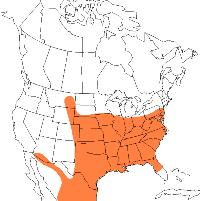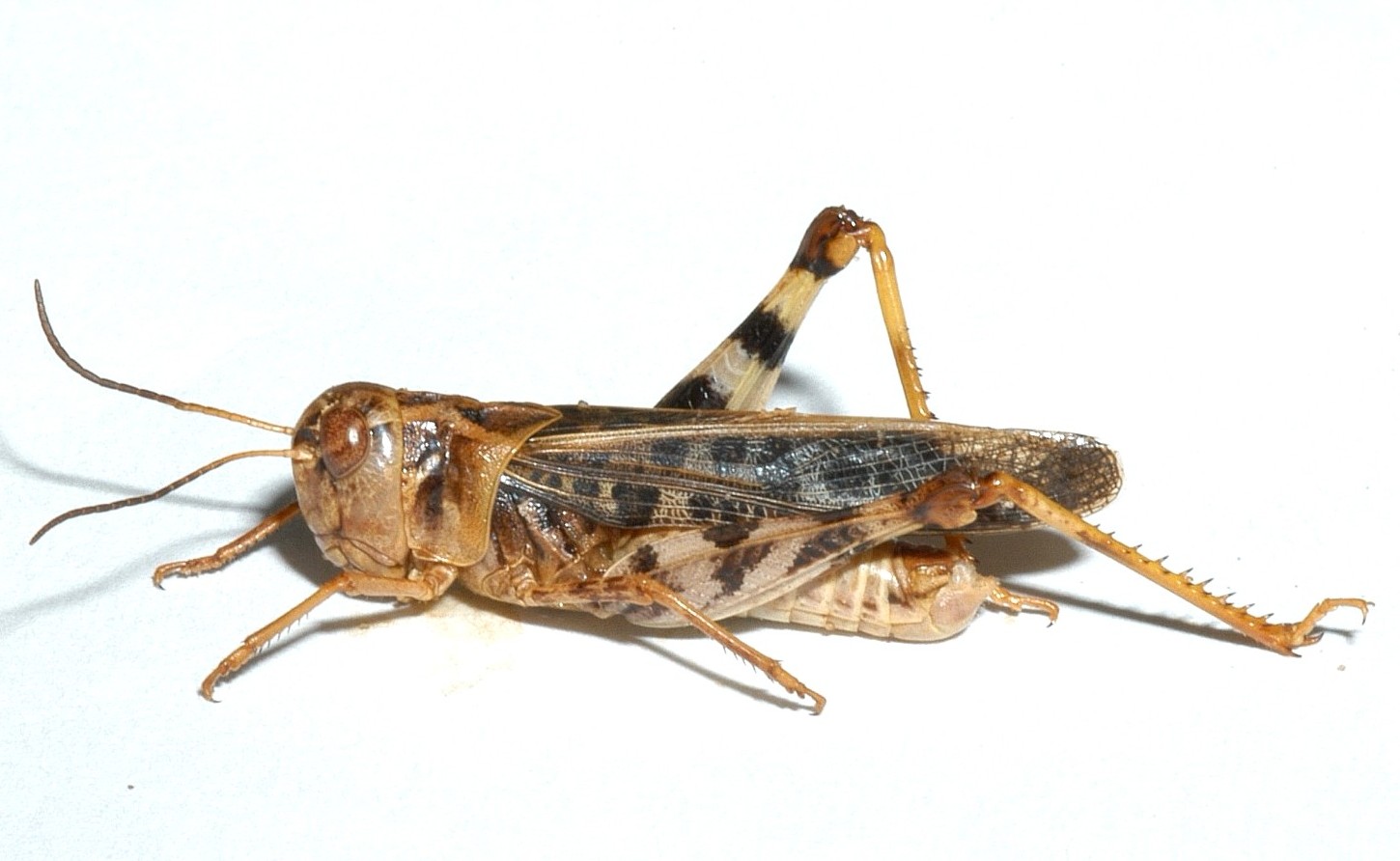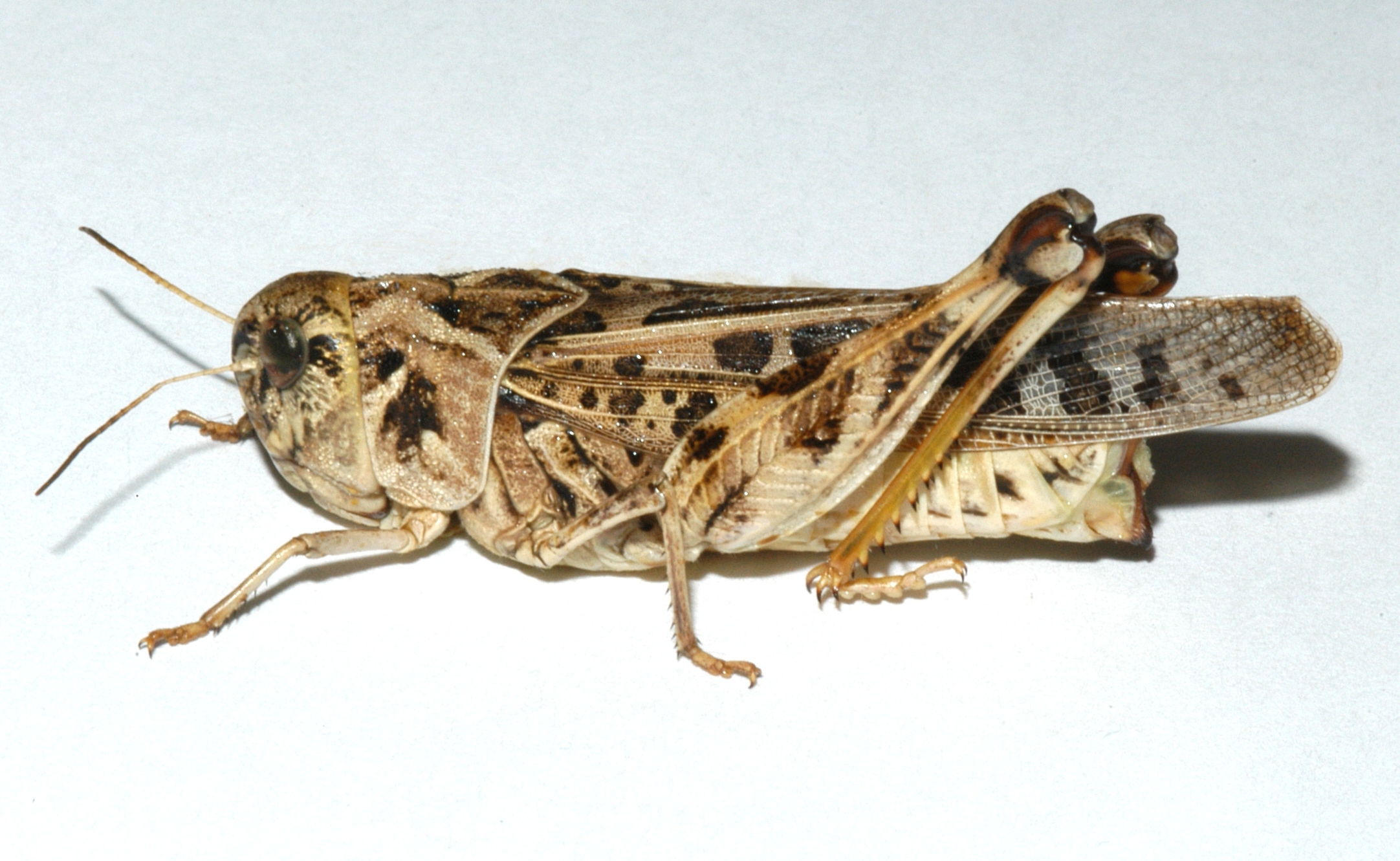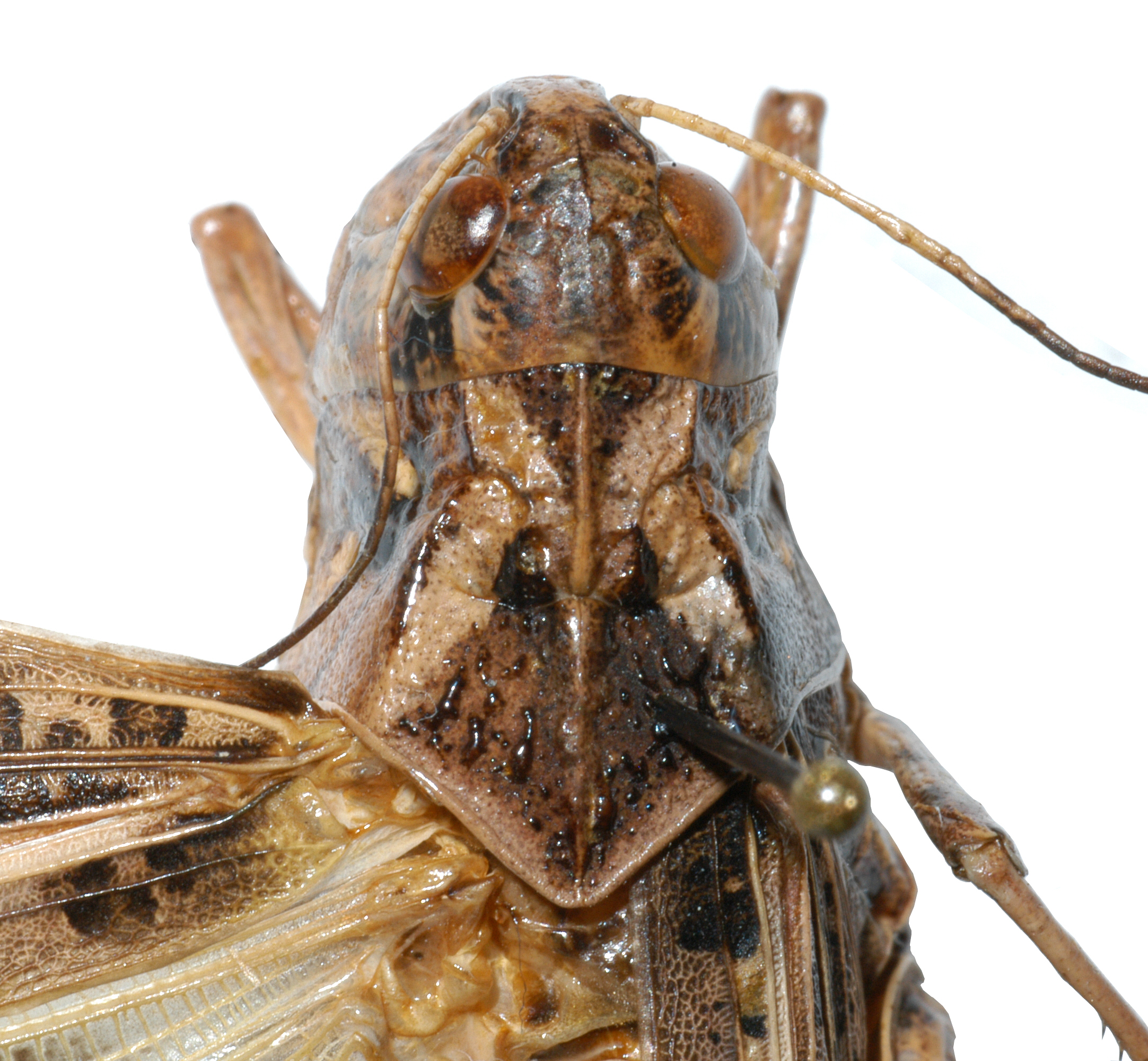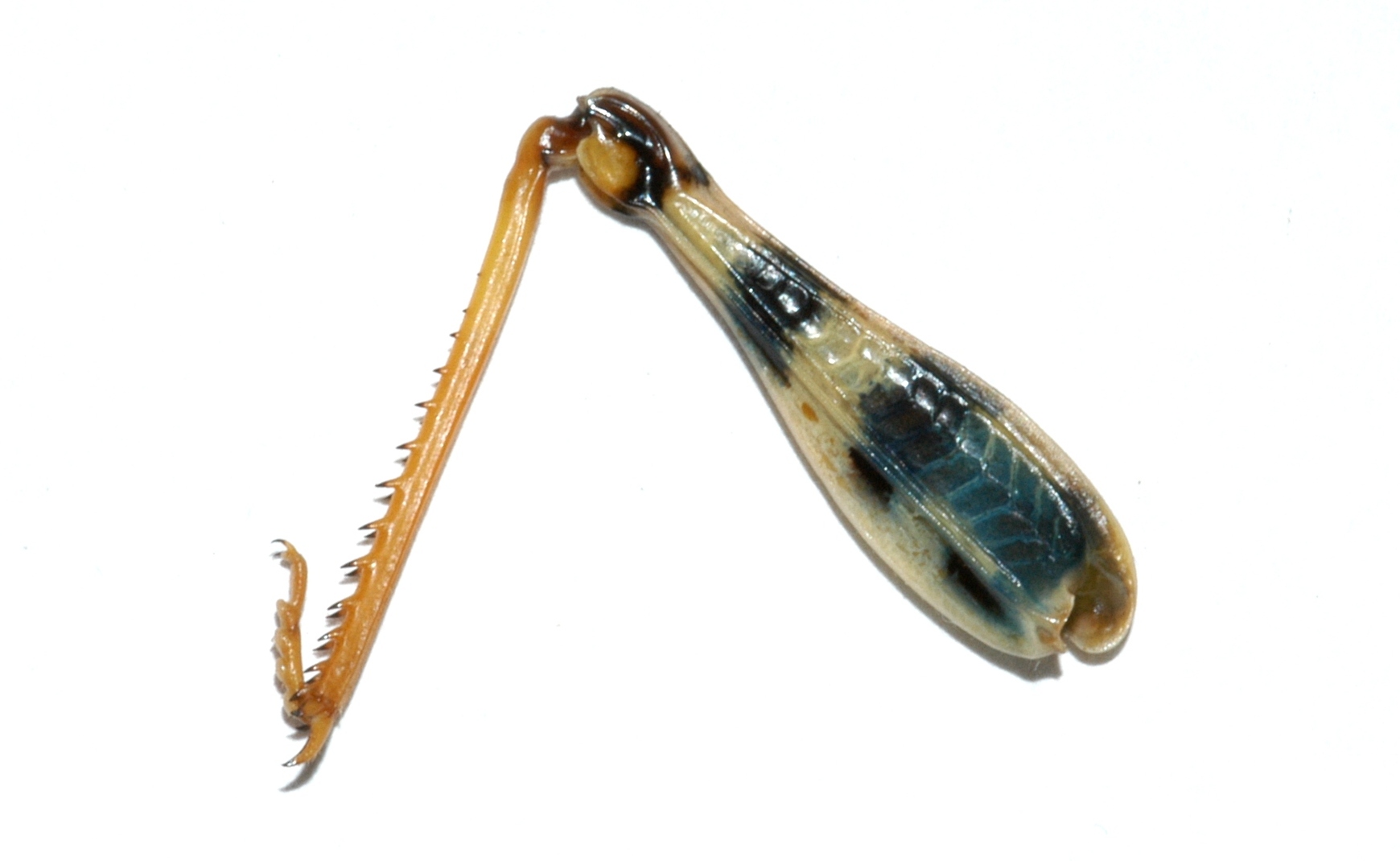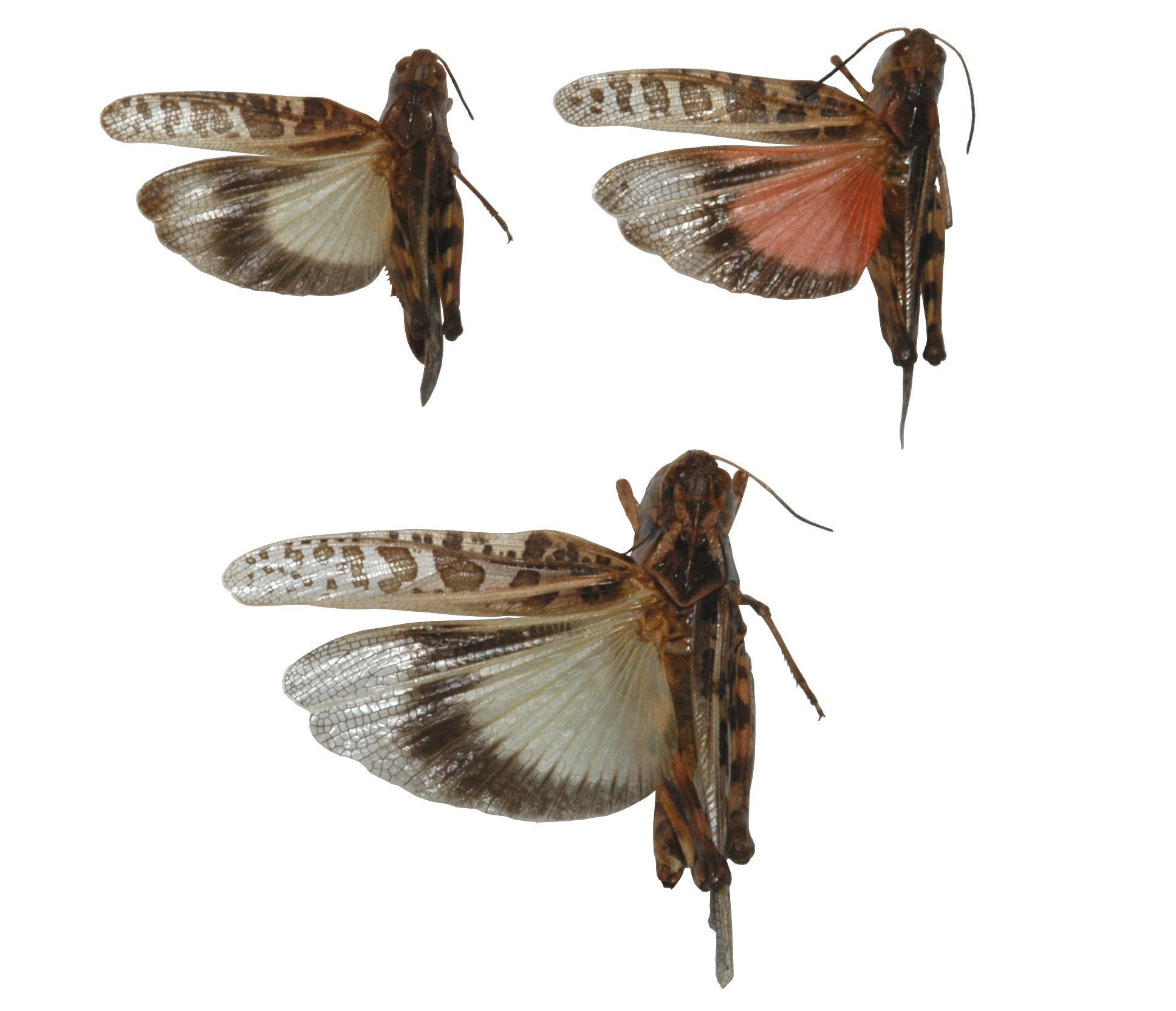Hippiscus ocelote
|
Geographic range of Hippiscus ocelote (Saussure) |
|
Fig.1, adult male |
|
Fig. 2, adult female |
|
Fig. 3, dorsal pronotum |
|
Fig. 4, inner hind femur |
|
Fig. 5, extended wings |
Species
Wrinkled grasshopper
Hippiscus ocelote (Saussure)
Subfamily Oedipodinae
Identification
A large and robust band-winged grasshopper ranging in color from gray to brownish with a brownish-yellow abdomen. The face is vertical and also brownish-yellow in coloration. Antennae slender with a yellow base and brown tip. Males are 28-40mm long, with the females being larger at 39-53mm.
The common name “wrinkled grasshopper” comes from the pronotum, which is wrinkled and course in appearance. The pronotum frequently has a faint X-shaped marking on the dorsal surface, which is more often seen in males. Two yellow spots are also apparent on the sides of the pronotum.
Tegmina are large and marked with dark spots and light colored stripes. When the wings are closed, the light banding of the forewings meets at the tip to form a “V”. Hind wing coloration is most often yellow, but may also range from orange to pinkish, with a dark submarginal band decreasing in pigmentation at the tip.
The hind tibiae are yellow to orange, pale in color at the base, and the inner apical spur is at least twice as long as the outer. The inner hind femur is yellow to almost whitish with three black bands.
Hippiscus ocelote could be mistaken as Xanthippus corallipes (the red-shanked grasshopper), or Pardalophora haldemani, but can be distinguished by the black banding on the inner hind femur, which is lacking in the other two species. Additionally, the pronotum of H. ocelote is cut by one sulcus, whereas the pronotum in the members of the genera Pardalophora and Xanthippus is cut by two to three.
Distribution and habitat
Hippiscus ocelote is common across the high plains of Colorado and Wyoming east to New Jersey and Florida, and south into Mexico. It has also been recorded from Montana and Arizona.
It prefers grassy areas in open woodlands, but also inhabits rangeland and pastures with short grass.
Economic importance
Suggested to be an occasional pest in pastures and rangeland. However, it seldom reaches high density and is not considered an economically damaging pest.
Food preferences
Feeds primarily on short-grasses, most notably bluegrass and Japanese brome, as well as blue grama and little bluestem.
Dispersal and migration
Although females are poor fliers, the males are quite active. Males normally take flight when disturbed, although they are clumsy.
Frequently found in roadsides and areas of low-growing grass, but migration into crops/fields would be unlikely as a result of low densities and feeding preference.
Hatching
Although little research has been conducted on H. ocelote, it has been shown that in Arizona, eggs and adults can overwinter, while only the eggs have been observed to overwinter in other regions of the United States and Mexico. Eggs hatch in the spring.
Nymphal development
Nymphal development lasts from mid-June to late August. Nymphs were shown to reach maturity by July 20th in Indiana.
Adults and reproduction
Adults are present from June to November, into winter in the southernmost parts of its range. Adults are most prevalent from September into November and it is normally one of the last grasshopper species seen prior to the winter months. Adults mate in late August and into September. During courtship, males stridulate and tap on the head of the female using their antennae. Reproductive behavior is similar to that of Pardalophora phoenicoptera and Xanthippus corallipes. Males die shortly after mating, while females may persist much longer. Eggs (usually 30) are arranged in three columns and are yellow to reddish-brown in color. Mean egg length is 6.8 mm with an average diameter of 1.7 mm.
Population ecology
Rarely found in high numbers and not economically important. This grasshopper prefers grasslands, open meadows, and woodlands where it feeds on a wide variety of grass species. In a study of 66 grassland sites in Colorado, 48 species of grasshopper were captured and only five were found in lower densities than H. ocelote. Will likely be found in the highest densities in tall-grass prairies and regions with greater diversity of grass species. Feeding preference and habitat choice are known, but this grasshopper is relatively understudied. It has been observed that this grasshopper is sometimes attracted to lights.
Daily activity
Little is known about the daily activity of H. ocelote.
Source and date
University of Nebraska by Sean Whipple & Mathew L. Brust June 2011
Selected references
Ball, E. D., E. R. Tinkham, R. Flock, and C. T. Vorhies. 1942. The grasshoppers and other Orthoptera of Arizona. University of Arizona College of Agriculture Technical Bulletin. 93: 275-373.
Beamer, R. 1917. The Oedipodinae of Kansas. University of Kansas Bulletin 18(1):51- 126.
Blatchley, W. S. 1920. Orthoptera of Northeastern America, with especial reference to the faunas of Indiana and Florida. The Nature Publishing Company, Indianapolis, Indiana. 784 pp.
Brust, M. L., W. W. Hoback, and R. J. Wright. 2008. The Grasshoppers (Orthoptera: Acrididae and Romaleidae) of Nebraska. University of Nebraska-Lincoln Extension. 138pp.
Campbell, J. B., W. H. Arnett, J. D. Lambley, O. K. Jantz and H. Knutson. 1974. Grasshoppers (Acrididae) of the Flint Hills native tallgrass prairie in Kansas. Kansas Agricultural Experimental Station Research Paper 19.
Capinera, J. L., R. D. Scott, and T. J. Walker. 2005. Field Guide to Grasshoppers, Katydids, and Crickets of the United States. Comstock Publishing Associates. 280pp.
Coppock, S., Jr. 1962. The grasshoppers of Oklahoma. Oklahoma State University Agriculture Experiment Station Bulletin, Processed Series P-399:1-141.
Craig, D. P., C. E. Bock, B. C. Bennett and J. H. Bock. 1999. Habitat relationships among grasshoppers (Orthoptera: Acrididae) at the western limit of the Great Plains in Colorado. American Midland Naturalist. 142(2): 314-327.
Helfer, J. R. 1972. The Grasshoppers, Cockroaches and Their Allies. W C. Brown Company, Dubuque, Iowa. 359 pp.
Mulkern, G. B., K. P. Pruess, H. Knutson, A. F. Hagen, J. B. Campbell, and J. D. Lambley. 1969. Food habits and preferences of grassland grasshoppers of the north central Great Plains. North Dakota Agricultural Experiment Field Station, North Central Regional Publication No. 196. 32 pp.
Onsager, J. A. and G. B. Mulkern. 1963. Identification of eggs and egg-pods of North Dakota grasshoppers (Orthoptera: Acrididae). North Dakota Agr. Exp. Stn. Bull. 446 (Technical).
Otte, D. 1984. The North American Grasshoppers, Volume II, Acrididae: Oedipodinae. Harvard University Press, Cambridge, MA. 366 pp.

